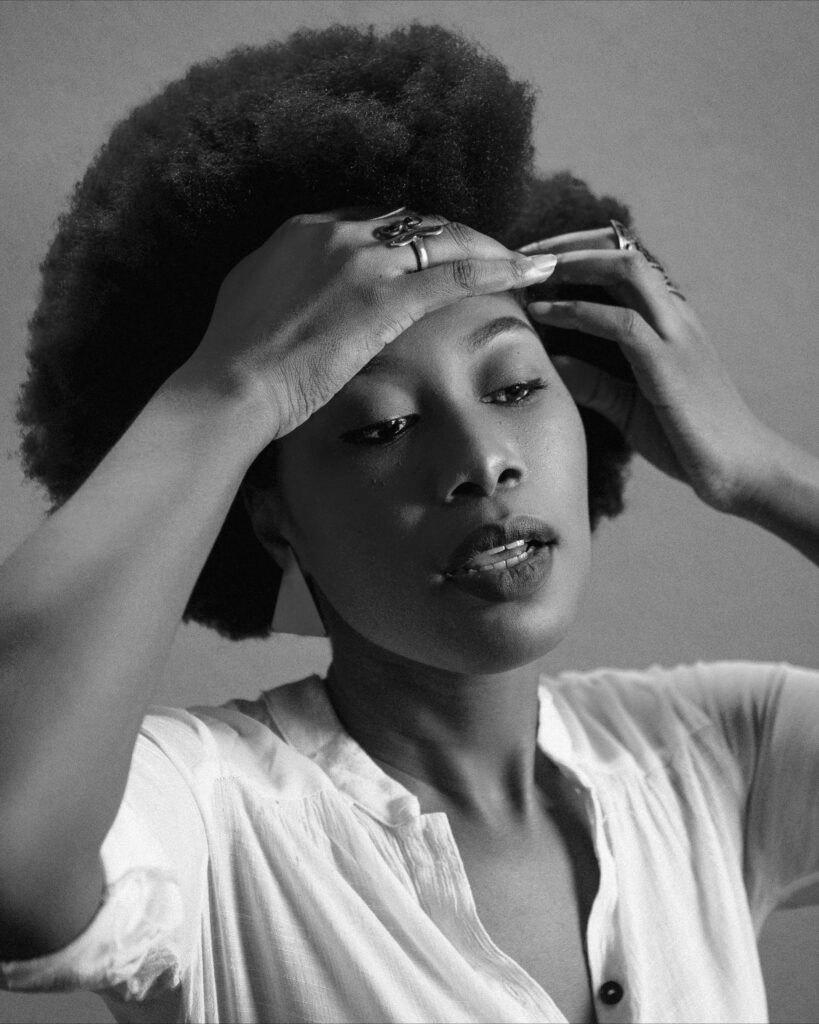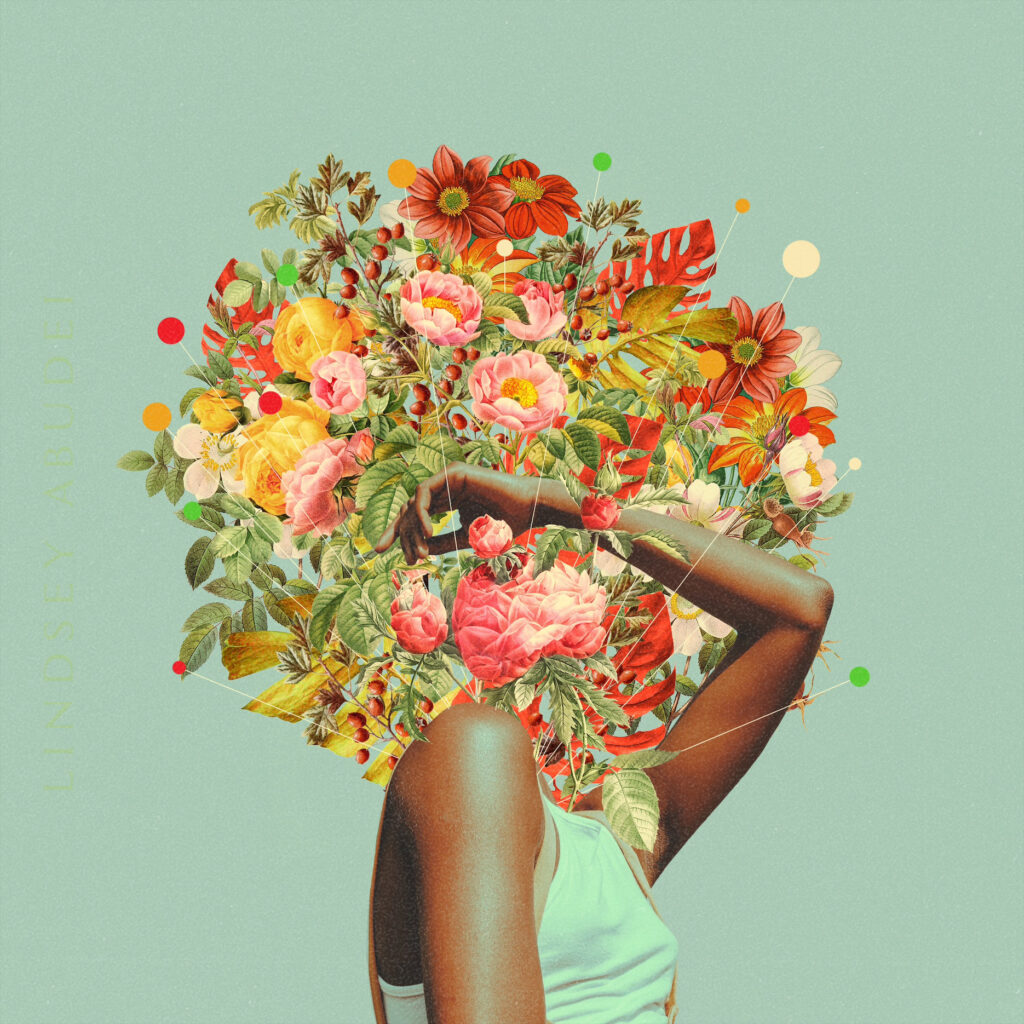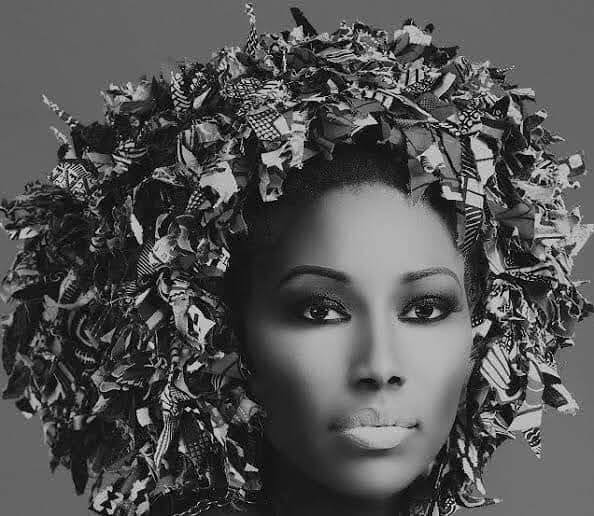“For my new EP, Kaleidoscope, I wanted to explore Electronica, and work with someone who had a good knowledge of the genre and was open to playing with different genres. Bigfootinyourface was one of the people I had on my list…”
By Hope Ibiale
Unique storytelling, compelling songwriting, and an enthralling voice leave you wishing to be a character in her songs. These familiar signifiers let you know that you have been drawn into the orbit of singer-songwriter and producer, Lindsey Abudei. The first time I heard Lindsey’s music, I was a teenager obsessed with music videos, and the characters in Lindsey’s “Out the Magazine” were comical and entirely relatable. Years later, I am still captivated by Lindsey’s music.

Lindsey recently added her new project, Kaleidoscope, to her discography. In a fashion not unusual to her work, the project boasts of stellar production, well-crafted storytelling, and Lindsey’s expansive vocals.
In a conversation with Afrocritik, we learn more about Lindsey’s beginnings, her current project, Kaleidoscope, her interest in photography, and her musical journey.
The first time I heard your music, my sisters and I were obsessing over music videos, and “Out the Magazine” began playing on the TV. Immediately, I became curious about who you were. Years have passed, and I am still interested. Tell us your story. Who is Lindsey Abudei?
Lindsey Abudei is enthusiastic about art and lucky to have a means or channel of creating expression through music and sound. I am a singer, songwriter, vocal composer, producer, and performing and recording artiste. I also have interests in photography, architecture, film, and design.
You have been in the music industry for over a decade. How has your experience been, especially with your background in Law?
My experience in the music industry is no different from any other person’s. It’s a learning curve, and it also has its peaks and valleys. The industry is constantly changing, so as an artiste, you have to keep abreast of the things that are happening and things that are changing, and you need to consistently be aware of the rules of engagement as they are made.
Regarding my background in Law, I may get a better sense of what an agreement is saying, but it is also important to note that Entertainment Law is not a field I specialise in. So, in the end, you return to the people who have a better sense of these agreements and have experience handling such issues. But as an artiste, I appreciate the part that Law plays in protecting the intellectual property of artistes and ensuring that there is no abuse or infringement in cases where wrong has been done. The Law helps create remedies for those wrongs.
When you started making music, you worked with MI Abaga and Jesse Jagz. How did that experience forge your path as an artiste?
When I started making music, it wasn’t just MI Abaga and Jesse Jagz I worked with. I also worked with Genie, and the South African singer, Sonti Mndebele, as a background vocalist during her tour in Nigeria. I knew Mndebele as one of the background vocalists doing Paul Simon’s Graceland tour in South Africa around Nelson Mandela’s incarceration. That concert was dedicated to advocating for Mandela’s release.
During this period, I was learning the ropes, getting comfortable with being a recording artiste, and polishing my performer skill; this was where it all started. I started performing live and doing the jam sessions we heard in Jos. It was a period where I learnt to write better. I also gathered my skill in recording, writing, and vocal arrangement.
Recently, there has been a renewed synergy between producers and musicians, leading to successful projects like LV N ATTN and many others. Now, in your latest project, you collaborated with BigFootinYourFace to create this beautiful work of art. What influenced your choice to work with Bigfoot?
I think what has happened is that artistes have worked as co-producers but have never been given credits as co-producers for projects. I think, this time, we are seeing more of that. This might makes it seem like it is just happening, but it has been there for a long time.
For my new EP, Kaleidoscope, I wanted to explore Electronica, and work with someone who had a good knowledge of the genre and was open to playing with different genres. Bigfootinyourface was one of the people I had on my list. I had heard his work before and put his name as one of the people I wanted to work with. When we met to talk about the project, I was hoping we would have chemistry, and I am thankful that we had that, so it was easier to bring ideas together and see how we could craft the sound we made for Kaleidoscope. Bigfoot is one of those producers who like to play around with things, and I appreciate that he has a good knowledge of music in general. He is also active in the Electronic scene, and I thought he would be a good collaborator.
African artistes have begun tapping into different music markets and collaborating with varying artistes within those spheres to bring their music to new audiences and expand their pool of loyal listeners. Is collaborating with other artistes, both local and international, something you plan on pursuing soon?
Regarding collaboration, I have been doing that for a long time. There’s no project I have done that I have not collaborated on with another producer. There is no song or vocal arrangement or co-production I have yet to do in collaboration with somebody else. There is no performance I have done without collaborating with another musician or other musicians. Collaboration has been a thing. We tend to forget that collaboration is what makes music most of the time. It doesn’t matter if you write the entire project; you collaborate with the engineer or others in the studio. It’s all collaboration.
So, I have been doing this for a long time. It’s not something I just started. Being an artist who has also been active in music and art residencies, collaboration is the pivot of what international music residencies are about. So, collaboration is part of my artistry. It makes my projects the way they are, whether from the art side or creative direction, sound, recording, or body engineering; all these have a part to play. But I am now at the point where I am trying to collaborate with visual artists as well. As far as collaborations go, I want to explore the intersections of music and other visual art forms, and that’s what I am now leaning towards.

In an interview with The Native magazine, you indicated that you want to explore photography. After that, we saw you collaborate with Ghanaian photographer, Kwasi Darko, on his photography project, HERE AND NOW. Should we be expecting a photography exhibition from you soon?
I worked as a sound collaborator on Kwasi Darko’s project, HERE AND NOW. In 2019, I also worked with Ivorian photographer, Keren Hasme, on her project, The Cosmic Dance. As I said earlier, I am now looking to explore the intersection of music and visual art forms. Presently, I am trying to incorporate my interests into my expressions, whether with sound or music.
I have mostly been photographing with my mobile phone, so you could call me a mobile photographer. I don’t know when I will have a photography exhibition, but I have thought about it.
How is writing for music, for photography, and visual expression different from writing an album or single?
The difference isn’t stark. But you could say when writing for a visual project, you could use the same approach when writing a film score. But at the same time, technology has introduced new approaches to visual art and photography in film that invite someone interested to explore a different experience. Because, as an artiste, you create an immersive sound experience while someone engages with something visual. I don’t think it is tailored to one thing. Depending on the project, there may be different requirements as time goes on. But the core of what music is for and how music is written are pretty much the same.
Over the years, you have been involved in various residency programs like Art Omi, ColabNowNow, and many others. How have these experiences shaped your musical journey?
The residencies I have been active in have helped in seeing how big the picture is regarding music and sound. It shows you can be in one corner of the world and think this is all that music is about, but these residencies have opened me up to see a bulk of what lies at the fringes, and it is fascinating to see. It has also made me better at collaboration and opened me up to the possibility of collaborations outside my primary discipline, music, and sound. It helped me see how I can find a different expression or collaborate with someone else in another field, especially as far as interdisciplinary or multidisciplinary collaborations go.
What’s that one thing you hope to have achieved at the end of this journey?
It’s not the end, so I don’t know. As the journey continues, the pillar keeps changing. When I take one step, there is a different post, so I can’t say what I hope to have achieved because I am still on the journey and taking it one step at a time.
Recently, you released your third body of work, Kaleidoscope. How has the reception to the project been so far?
The reception has been good.
What inspired the name, “Kaleidoscope”?
Kaleidoscope is inspired by its literal meaning, but to customise its meaning as far as this project is concerned, it explores diverse genres and elements of different genres. There are elements of Classical, Orchestra, Folk, and Electronica. There is also an exploration of how the stories are told from first person to third person and also trying to create an omnipresent perspective, especially in tracks like “Ànị’s World.”
I wanted to explore or have a way of processing the emotions and experiences I have dealt with in the past three years and put them in a way where I am feeling through loss, grief, and doubt.
You wrote Kaleidoscope as a soundscape for visual and performance presentations, film, photography, and theatre. How do you plan to achieve this goal?
That would be for you to find out. Fingers crossed.
Which song on the Kaleidoscope was most endearing to make?
All the songs were endearing to make in their way.
While talking about Kaleidoscope, you said, “I wrote and recorded ‘Kaleidoscope’ in the middle of many emotions, emotions that were a culmination of my last three years. I wade through feelings of doubt, of loss, asking questions about my place, purpose with the hope to find clarity in the muck.” How has the process of creating Kaleidoscope affected those emotions? Did the therapeutic feel of making music bring some clarity?
I am still in the process of it. I have had a channel through Kaleidoscope to acknowledge these feelings, but I am still wading through those emotions.

Unlike your previous projects, Kaleidoscope is tailored with intermissions that draw inspiration from parables from the Bible and Ànị, the goddess of fertility. What was the thought process behind this decision?
The songs and the intermissions on the project reference the Bible, art, Greek mythology, and Igbo folklore, where Ànị comes from. Ànị is the goddess of earth, fertility, and morality.
In general, the idea of these songs, the intermissions, and the references was to create a very visual landscape for which the songs were written. Like I said earlier, this EP was written differently from the way I have written other projects, because in this project, it was almost like I saw everything play out visually, and what I wrote and what you hear as the songs or the intermissions are like dictations from what visually occupied my mind and the way that I saw these things. So, these references are tangible ways to connect the stories being told with the visual landscape I try to create with Kaleidoscope.
On your previous projects, you have told stories about love, loss, freedom, etc. This ability to deploy art for a specific emotional purpose, to tell different stories, is unique. How have you continuously crafted new stories for each project?
Everything boils down to experience as a human being and other people’s experiences. Also, my imagination plays a role, too. I don’t think I would be able to create if I didn’t have my imagination or live the way I did when I was a kid.
Hope Ibiale is a writer and a book lover. She is currently a student of Communication and Language Arts at the University of Ibadan.




